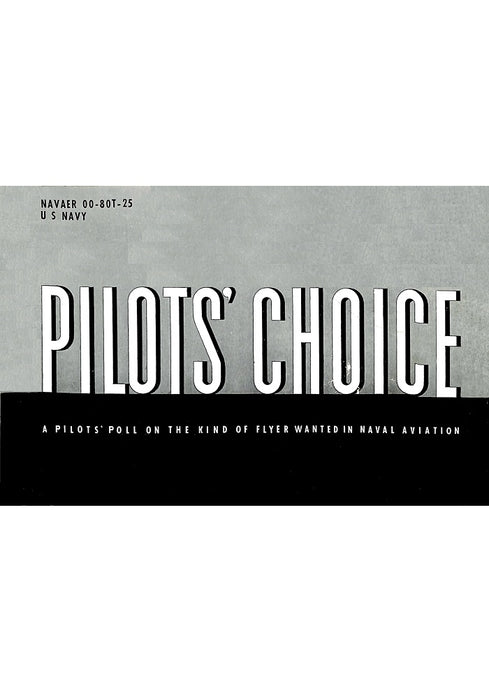
Pilot's Choice (ebook)
Pilot’s choice
61 pages – in English - PDF to download
This booklet was intended to instill in each new US Navy pilot the qualities expected of him.
Under authorization from DCNO (Air), trained interviewers were stationed aboard certain carriers. at specified land bases, and at strategic points within the continental limits. They conducted individual interviews with more than 1,000 combat-experienced pilots under official guarantee that statements made in the interviews would be used for research purposes only. Men flying single-engined aircraft were asked to pick .the two men (living or dead, regardless of rank) on whom they would most like to fly wing, and the two men they would least like to have flying wing on them in combat. Pilots of multiengined aircraft were asked to name the two men for whom they would most like to serve as copilot and the two they would least like to have as their own copilot.
Their answers did not ordinarily come in the single-sentence form used in the quotations cited in this booklet. Usually, the replies took the form of the following description of a wanted VF pilot:
"As a division leader, lie not only thinks for himself but is also exceptionally considerate of his wingmen. He is a good navigator and knows his position at all times so his section can concen¬trate on flying a good wing. He is conscientious in reading technical data and especially so in briefing before strikes, so that lie always knows exactly what is going on, planes involved, radio calls, etc. In combat he is aggressive but not foolhardy, and he never forgets the primary pur¬pose of the mission. He is very enthusiastic about flying. In his division he demands good air discipline, and I don't believe he ever lost a wingman."
In contrast, here is the description of a pilot who was not wanted in a dive-bomber squadron:
"He is an individualist who will not practice teamwork. Could never be depended on to do a job, inasmuch as he would perform erratic maneuvers all over the sky, when he should have been in a definite position at a definite time. At one time he flew directly into another wingman who was flying correct position. Both planes were demolished and both pilots narrowly escaped death. Recently he bailed out of a plane which, in the opinion of those who saw it, could have been safely landed. He has torn up two other aircraft besides these two. He has always abused his airplane. Time and time again he has exceeded engine-operation limits, stress limits, and overload."
The men interviewed supplied the names of about 2,000 wanted and approximately the same number of not wanted pilots; and they gave descriptions of each man named. There weren't 2,000 different names at the two ends of the scale, since many pilots were named as wanted—or as not wanted—by more than one person. Agreement in appraising men as very good or very poor ran high. At the same time, once a man had received even one vote as wanted, the chance of his ever getting a vote as not wanted was very small.
The pilots who gave these descriptions employed approximately 10,000 identifiable reasons (about 3 reasons for each name on the average) in telling why they wanted or did not want a given man to fly with them in combat. Because they agreed very well as to what they wanted and did not want in the men flying with them, it was found possible to sort almost all of this material into less than two dozen pigeon¬holes. The titles of the pigeon-holes are given in the bold-faced type which heads the wanted and the not wanted quotations on the pages of this booklet.
It should be said again that the reasons cited in these pages are those given by the veteran pilots. They are not the work of some self-styled "expert" who has never seen a shot fired in combat. Because the statements come straight from the men who have been flying against the enemy, they offer you your best chance to get the word as to what is really wanted in the combat area.










